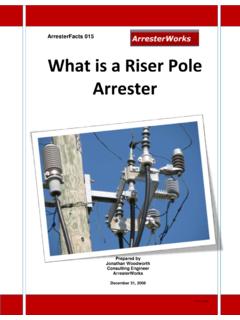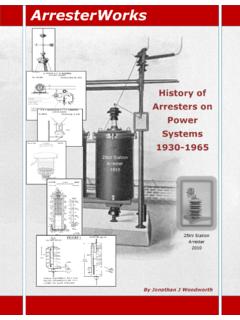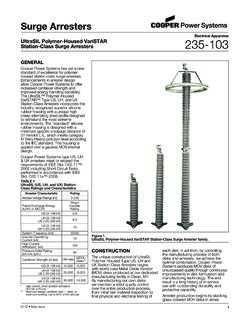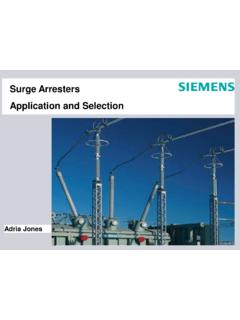Transcription of Application Considerations for Gapped Silicon-Carbide ...
1 Application Considerations for Gapped Silicon-Carbide Arresters Currently Installed on Utility High Voltage Installations Dennis W. Lenk, Fellow, IEEE Abstract Utilities have expressed concern recently about the electrical integrity and performance capability of the large number of Gapped Silicon-Carbide arresters that they currently have installed on their operating system. These arresters, manufactured from the early 1950s thru the late 1970s, were the state-of-the-art overvoltage protection device at the time they were installed. While these Gapped Silicon-Carbide arresters have a good service history, current state-of-the-art metal oxide arresters provide an opportunity to upgrade arrester performance and improve service reliability.
2 This paper discusses some of the issues that should be addressed in evaluating these arrester installations. I. Introduction From the mid 1950s through the late 1970s, Gapped Silicon-Carbide arresters represented the state of the art overvoltage surge protection used on distribution through high voltage transmission systems. With the development of metal oxide disc technology in the mid-late 1970s, manufacturers replaced the traditional Silicon-Carbide gap design with a gapless MOV arrester having improved performance characteristics.
3 While the Gapped Silicon-Carbide technology relied on both the gap and the Silicon-Carbide valve block to operate properly, the high exponent characteristic of the metal oxide varistor disc negated the need for a series connected gap. Design improvements were incorporated into Gapped -silicon carbide (SiC) arresters over the 25+ years that they were manufactured, but the basic technology did not change. This paper discusses some of the significant performance characteristics of conventional Gapped SiC Intermediate and station class arresters and comparably rated gapless metal oxide (MOV) arresters.
4 While Gapped SiC arresters have, in general, had a good service history, utilities continue to evaluate their overvoltage protection needs, in particular at critical locations that are currently protected by Gapped Silicon-Carbide arresters. This paper discusses some of the issues that should be addressed in evaluating these applications, including: o arrester Integrity o Protection/Margin o Pressure Relief capability o TLD/Energy absorbing capability II. Brief History surge arresters are applied on power systems to protect equipment insulation from damage associated with overvoltage surges on the power lines.
5 These surges can take many forms, ranging from lightning to capacitor bank to line switching surges. The design of the earliest SiC arresters consisted of a simple multigap configured in series with non-linear silicon carbide valve blocks. A common characteristic of all SiC designs was that the gap design, under normal operating conditions, withstood total line-to-ground system voltage. In the simple multigap configuration, the gap was the brains of the design. It responded to an overvoltage condition on the line and sparked over preventing damage to line/equipment insulation.
6 Once the gap sparked over, 60 Hz power follow current flowed through the series gap-valve block combination. The non-linear valve block limited the magnitude of the follow current to a level that the series gap could interrupt. Power follow current interruption on a properly functioning arrester , designed with a simple multigap, typically occurred on the first voltage crossing of the power frequency voltage following the overvoltage surge . This gap reseal completed the arrester operation and the system voltage again appeared across the gap. The multigap design worked quite well at distribution voltages but, for higher system voltages, resulted in very tall arresters.
7 In addition, since all the energy absorbing during the arrester operation was done by the valve blocks, a large quantity of valve blocks were required for the arresters to function large quantity of valve blocks resulted in very high discharge voltages, accompanying the already high sparkover levels for these multigap SiC arresters. During the late 1950s, the first current limiting (CL) gap arrester was introduced. Unlike the simple gap design which basically provided a sparkover and reseal function, the CL gap was designed to help limit system follow current by developing a back EMF.
8 This back EMF , in combination with the valve block current limiting, actually caused follow current interruption prior to zero voltage crossing. Figure 1 shows a comparison between the duty cycle oscillogram of the simple SiC multigap design versus the SiC CL design. Figure 1 Implementation of the current limiting gap significantly reduced the energy absorbed during the duty cycle operation, ultimately allowing arrester designers to reduce the quantity of valve elements inside the arrester . This ultimately resulted in shorter arresters with reduced discharge voltage levels.
9 These stepped reductions in discharge voltage resulted in stepped reductions in BIL/BSL margins. III. Protection/Insulation Coordination For Gapped SiC arresters, the protective margin between equipment insulation and arrester protective levels is a function of the highest of either the arrester discharge voltage or the arrester sparkover voltage (2). In the switching surge region, the BSL margin of protection is determined by the magnitude of the arrester switching surge sparkover. The BIL margin, however, is determined by the highest of either the arrester x 50 impulse sparkover or the discharge voltage level for an 8/10 discharge current waveshape of 10 or 20 kA.
10 The FOW/chopped wave margin is determined by the arrester FOW sparkover characteristic. It was previously noted that the introduction of the CL gap allowed arresters to be designed with reduced discharge voltages. To take advantage of the discharge voltage reductions, extensive design work was performed to reduce sparkover levels of these arresters. These evolutionary reductions resulted in the lowering of equipment insulation levels, while still maintaining acceptable protective margins. During the 25+ year manufacturing period of Gapped SiC arresters, there were significant reductions in the discharge voltage and sparkover levels for these arresters.









